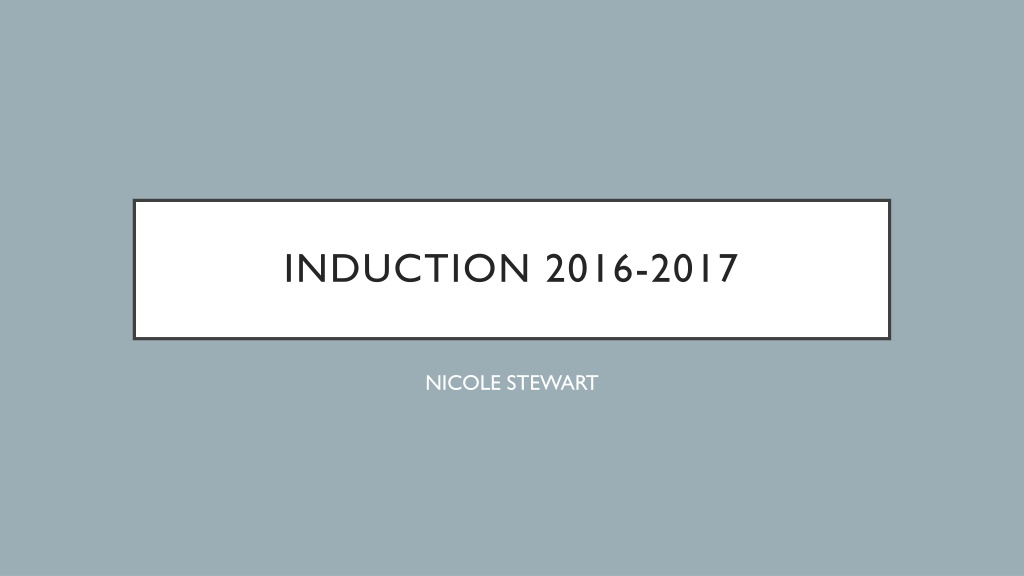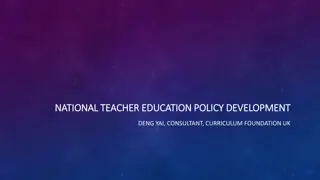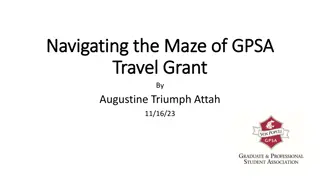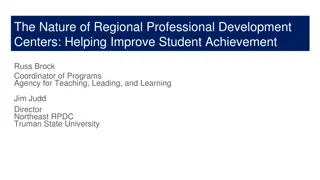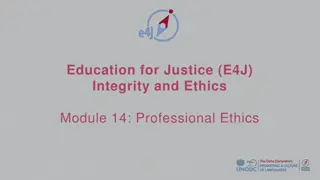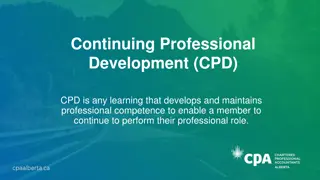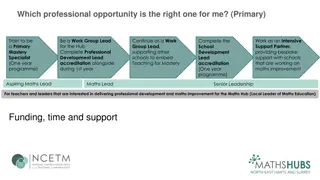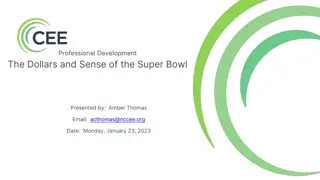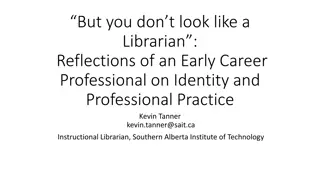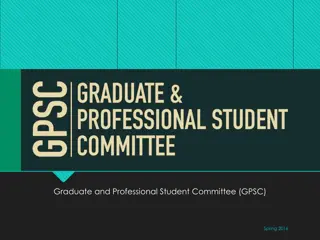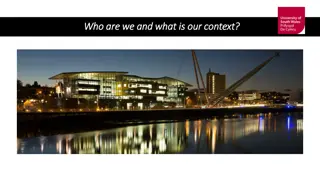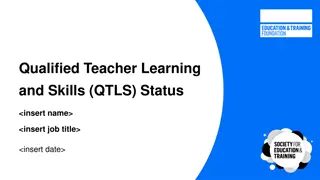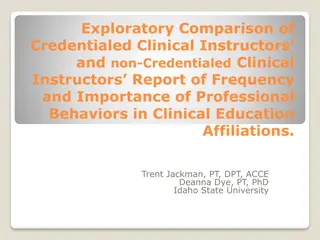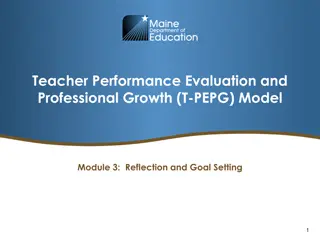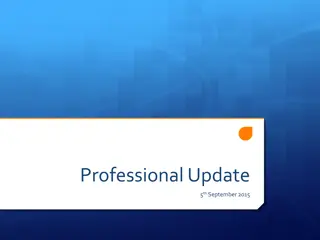Professional Development Insights in Education
Online courses and trainings like Reading Across Content Areas, Gifted Education 101, SIOP Training, and AVID Training have provided valuable instructional strategies and insights for enhancing literacy, working with diverse student populations, and promoting higher-order thinking skills in the classroom. These experiences have equipped me with tools and resources to support student learning and differentiation, emphasizing the importance of vocabulary building, differentiation, and rigorous instruction across content areas.
Download Presentation

Please find below an Image/Link to download the presentation.
The content on the website is provided AS IS for your information and personal use only. It may not be sold, licensed, or shared on other websites without obtaining consent from the author. Download presentation by click this link. If you encounter any issues during the download, it is possible that the publisher has removed the file from their server.
E N D
Presentation Transcript
INDUCTION 2016-2017 NICOLE STEWART
RESUME See Portfolio for Updated Copy of Resume.
READING ACROSS CONTENT AREAS This online course gave me so many instructional strategies to use in order to emphasize literacy in all content areas. This is easy to do in many content areas, but I struggled a bit to connect literacy and math. One of the tools from the course that I used over and over in math classes was word mapping new vocabulary and helping students to make connections to the words so they would remember the vocabulary. This course gave more resources for vocabulary and comprehension than I was able to use in a school year, but I am sure that I will keep coming back to these resources over and over again. Standards: 1a, 1b, 1d, 1e, 1f, 3e
GIFTED EDUCATION 101 This was a full day training that was offered by the Colorado League of Charter Schools. The training took place at the Academy for Advanced and Creative Learning in Colorado Springs. This is a school for students who are gifted and talented and it looks a lot different than most schools. One of my responsibilities this year, in addition to teaching special education, was to work with our Gifted and Talented students. This training gave me extensive background information on this population of students, what we must do in working with them, and how teachers need to differentiate instruction for them. I was able to train the staff at my school on their role in working with this population and I saw some positive things come from it. Standards: 2a, 2b, 2c, 2d, 3a, 3b, 3e
SIOP TRAINING SIOP (Sheltered Instruction Observation Protocol) is a way of teaching that really focuses on English Learners, however, I found it to be extremely helpful for my special education students also. SIOP focuses on vocabulary and helping students connect to and internalize unfamiliar vocabulary. Some of the strategies that I found most helpful were building background, word walls, pictures, audio versions of text, highlighting/underlining, predicting, rereading, mapping information, cooperative learning, using wait time to allow students to figure out answers, and making the delivery of lessons relevant. Standards: 2c, 2d, 3c, 3e, 1c, 2b, 3g, 6a
AVID TRAINING AVID Training focused on using inquiry based instruction to increase rigor in the classroom. Students should be asking questions, interacting with the material, and thinking on higher-order levels. Questions teachers can ask include: What do you think? Why do you think that? How do you know this? Can you tell me more? What questions do you still have? Some ways to engage students in higher-order thinking are: philosophical chairs, critical reading, marking the text, Socratic seminars, and WICOR (writing, inquiry, collaboration, organization, reading). Standards: 2g, 2h, 2c, 2d, 3c, 3e, 3f, 3g, 3h, 1c, 1d, 6a
ENET COURSE: CREATIVITY IN THE MOBILE CLASSROOM This online course gave me so many valuable resources for using technology in the classroom. One of the challenges that I faced this year was a lack of technology in the school that I worked in. Previously, I taught with a full set of iPads and ran a paperless classroom, so it was an adjustment being without technology. The course provided lists of applications for organization, collaboration and communication, education, game-based learning, different subjects, and teacher productivity. I was so excited to try some of them that I ended up buying a second personal iPad to use in my classroom. The use of technology really enhanced my teaching. Standards: 3d, 2d, 3e, 1c
UNC COURSE: LEADERSHIP DEVELOPMENT THROUGH INQUIRY This course was taken as a requirement for my Educational Leadership/Special Education Administration degree. The foundation of this course was reflection on leadership. We were able to reflect on our past experiences and how they shaped us as a leader. We were able to observe other leaders and evaluate the good and the bad in their styles of leadership. While this course was aimed at those entering administration, I believe it is important for everyone in education to reflect on these things. Teachers must be involved in the leadership of the school and this course gave me more confidence to step up and lead as a teacher. Standards: 3f, 5a, 5b, 5c, 5d, 2e
BOOKS READ First Year Teachers Survival Guide by Julia G. Thompson Tools for Teaching by Fred Jones Teach Like A Champion by Doug Lemov Quantum Teaching: Orchestrating Student Success by Bobbi DePorter, Sarah Singer-Nourie, and Mark Reardon The Jossey-Bass Reader on Educational Leadership - various authors Leadership Theory and Practice by Peter G. Northouse Standards: 2a, 2f, 3g, 3h, 2e, 4a, 4b, 4c, 6a, 6b, 1d, 2b
SELF-REFLECTION Quality Standard 1 Element A: Reading Across Content Areas; District Professional Development Element B: Reading Across Content Areas Element C: SIOP Training; AVID Training; ENet Course Element D: AVID Training; Reading Across Content Areas; Books Read Element E: Reading Across Content Areas Element F: Reading Across Content Areas; Books Read
SELF-REFLECTION Quality Standard II Element A: Gifted Education 101; Books Read Element B: Gifted Education 101; Books Read; SIOP Training Element C: Gifted Education 101; SIOP Training; AVID Training Element D: ENet Course; Gifted Education 101; SIOP Training; AVID Training Element E: UNC Course; Books Read Element F: Books Read
SELF-REFLECTION Quality Standard III Element A: Gifted Education 101; Books Read Element B: Gifted Education 101; Books Read Element C: SIOP Training; AVID Training Element D: ENet Course Element E: Reading Across Content Areas; Gifted Education 101; SIOP; AVID; ENet Course Element F: AVID Training; UNC Course Element G: AVID Training; Books Read; SIOP Training Element H: AVID Training; Books Read
SELF-REFLECTION Quality Standard IV Element A: Books Read Element B: Books Read Element C: Books Read
SELF-REFLECTION Quality Standard V Element A: UNC Course Element B: UNC Course Element C: UNC Course Element D: UNC Course
SELF-REFLECTION Quality Standard VI Element A: Books Read; SIOP Training; AVID Training Element B: Books Read
PROFESSIONAL DEVELOPMENT PLAN I want to create a safe, inclusive, and respectful learning environment for the special education students that I teach (Quality Standard II). I want to deliver effective, differentiated instruction (Quality Standards I & III). I want to reflect on what I am doing and have done, demonstrate leadership, and take responsibility for student growth and achievement (Quality Standards IV, V, & VI).
ARTIFACTS See Portfolio for Artifacts.
MENTOR LOG See Portfolio for Mentor Log. Logged 81 hours this year. Mentor was instrumental in the completion of this program. I was able to bounce ideas off of her, share my frustrations with her, ask her questions and for advice, and celebrate my victories with her. She was encouraging and supportive and always honest even when it wasn t easy to be. Having a mentor to help me through this program was extremely helpful.
PERFORMANCE EVALUATIONS See Portfolio for Performance Evaluations.
